1700s Napoleon Bonaparte Review of the Troops Print
The Consulate and the Empire are 2 fundamental periods in the history of France and of Europe. Hither you tin read virtually Napoleon's early on years, his coming to power, and other events during his reign. Some of these dates are expressed using the arrangement of the Republican calendar. Click hither to find out more than about the Republican calendar.
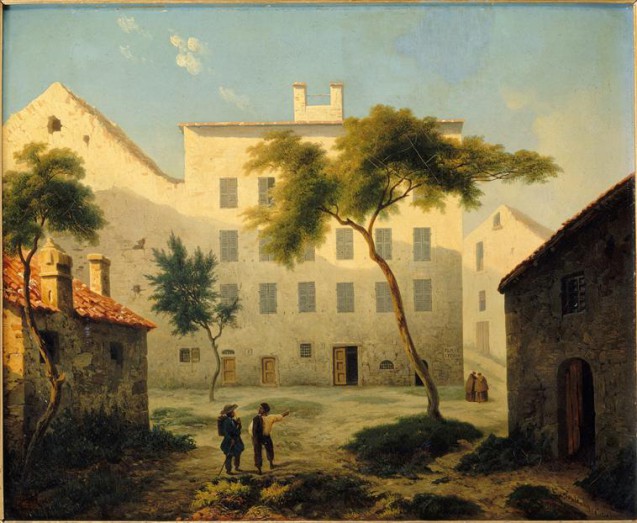
1769 – THE Nativity OF NAPOLEON BONAPARTE
On 15 August 1769, Napoleon Bonaparte was built-in in Ajaccio, in Corsica. The Bonapartes were a noble family who endemic state, vineyards, and a comfortable house, only they were non ever well-off. Bonaparte'south father never stopped trying to consolidate his family's wealth and social standing. In 1771, he succeeded in having his family'due south noble Tuscan origins recognised past France, which meant that not only could his sons benefit from report grants handed out past the king, but they could also attend schools reserved for the nobility. Napoleon's showtime few years at school in Autun and and then at military school in Brienne were difficult: his Corsican accent and his solitary nature often singled him out for teasing and jokes. He then moved onto war machine school at Paris where he received his officeholder'due south diploma on 28 October 1785. His commencement regiment was stationed in Valence, in the south of French republic.
Did you know? Corsica was a dependent of the Genoan Commonwealth until 1768, when information technology came under French control.
Illustration: Léonard-Alexis Daligé de Fontenay,The birthplace of Napoleon I in Ajaccio © RMN-Grand Palais (Musée des Châteaux de Malmaison et de Bois-Préau) / Jean Schormans
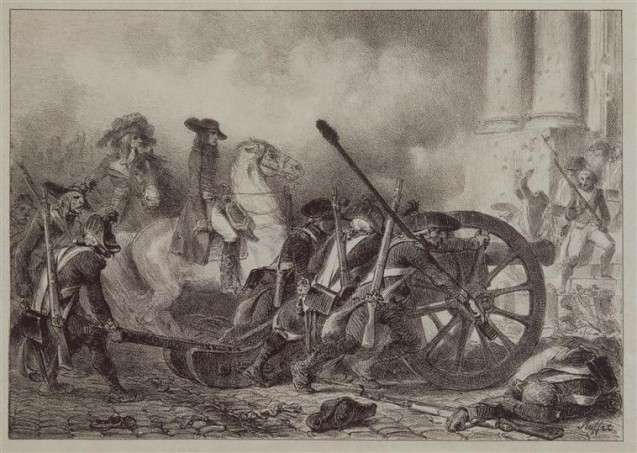
1789 – NAPOLEON AND THE FRENCH REVOLUTION
From 1787, Bonaparte alternated between Paris and Corsica. In Ajaccio, he participated in politics, supporting the unification of Corsica with France. This brought him into conflict with Pascal Paoli, who advocated Corsican independence and who was supported by the English.
The French Revolution in 1789 pitched the defenders of the monarchy, the privileged aristocracy and the high-ranking clergymen against the partisans for a more egalitarian gild, known as republicans. The insurrection crystallized with the abolition of privileges on August 4, 1789. Bonaparte was only xix years old. The revolutionary legislative assembly, which was to transform the absolute monarchy into a constitutional monarchy, gave way to the Convention in 1792, which prepare the First French republic. The new authorities tried to find a remainder between the moderates (Girondins) and the more than radical faction (Montagnards).
After the king was executed in 1793, political life was irredeemably and dramatically changed. The Regime known as the "Terror" was imposed by the Montagnards. The same year, 1793, because of their allegiance to the Convention, and opposition to Corsican Independence, the Bonapartes were forced to leave the island and seek refuge in Toulon, on the south declension of France. Whilst the Terror ended on the 9 Thermidor Year II (July 27, 1794), a new constitution was drawn up for a year, culminating in the Convention of 5 Fructidor Year Three (22 Baronial 1795). In Paris, Napoleon took part in burdensome the royalist insurrection against the Convention (13 Vendémiaire Year IV (v October 1795), which resulted in his beingness named Division Full general on 16 October 1795.
Did you know? On ten Baronial 1792, Napoleon was nowadays at the storming of the Palais des Tuileries, during which the palace was sacked and pillaged, the Purple Guard massacred and the Royal family unit forced to seek refuge at the Assembly. Greatly influenced past this dramatic experience, Napoleon would later focus all his attention on avoiding popular uprising in Paris during his reign.
Analogy: Raffet, "13 vendémiaire, Saint Roch 1795" (detail), Musée National du Château de Malmaison © RMN
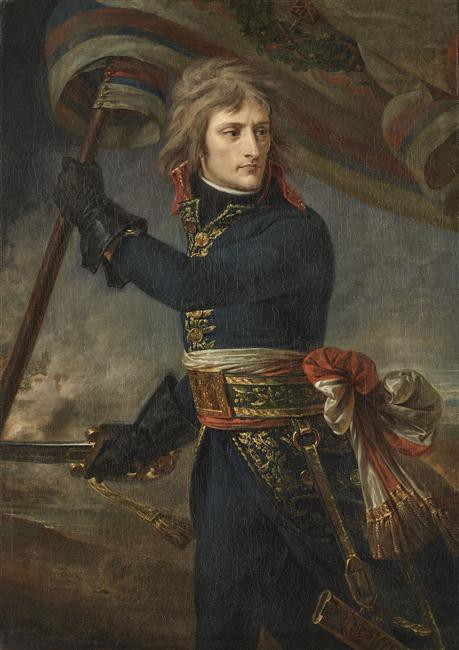
1796 – THE FIRST ITALIAN CAMPAIGN
On ii March 1796, the Directory named Napoleon Commander-in-master of the Armée d'Italie and dispatched him with orders to counter Austrian influence in Italian territory. The Convention thus wanted to help young republics known every bit "sisters" of the Revolution to gratuitous themselves from the monarchies of the Ancien Regime and spread revolutionary ideals. This programme too aimed to oblige the enemy European powers of the Commonwealth, united in coalition, to let become of the front that they had opened in French republic in 1792.
The young full general was able to put into exercise the armed forces strategy that he had been developing in the class of his reading: target the enemy'southward weak betoken, movement quickly, and assail with surprise to gain a psychological advantage. April and May 1796 were marked by a series of victories, but in the summer, the Austrians took the reward. On xv November, Napoleon launched an attack near Rivoli, and afterward 3 days of fighting, achieved victory. The Austrians signed the treaty of Campoformio on 17 October 1797. Seven victories in seven months confronting a much larger army demonstrated that General Bonaparte was a groovy strategist. He as well turned his hand to installing new 'sister' republics in Italy (the Cisalpine Republic and the Ligurian Republic).
Did you know? It was during this first campaign that Napoleon began to create the prototype of his invincibility and divine providence. He founded two newspapers, Le Courrier de l'armée d'Italie and La French republic vue de 50'armée d'Italie, intended to maintain army morale and to inform the French public of their Full general-in-main's victories. "Bonaparte flies like lightning and strikes like thunder. He is everywhere and sees everything. He is sent by the Great Nation." Information technology was a publicity campaign before its time!
Portrait: Gros, "Full general Bonaparte on the bridge of Arcola, 17 Nov 1796", © Château de Versailles Dist. RMN-Grand Palais / Christophe Fouin
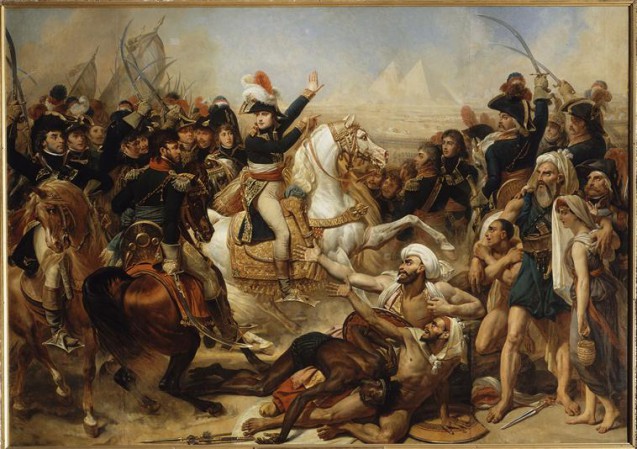
1798 THE EGYPTIAN EXPEDITION
In 1798, the Directory sent Napoleon to Egypt to combat England's growing commercial influence in the expanse. Keeping the trek secret for every bit long as possible was crucial; to slow whatever possible counter-attack by the English Navy, commanded by Admiral Nelson, Napoleon had his ships leave from unlike ports. Landing in Alexandria on 1 July, Napoleon and his troops were faced with a very hot climate and an uninhabitable terrain, blessed with very few resource. Nevertheless, the French army challenged and overturned the army of Mamluks, (reputed warriors, kidnapped in their youth in Muslim countries and fastened to a sultan or caliph, whose leader, on the orders of Mourad Bey, had taken power with Ibrahim Bey in Arab republic of egypt), at the Battle of the Pyramids near Cairo on 21 July. The French settlement in Cairo provoked an uprising of the native inhabitants which was harshly suppressed. At the same time, the French fleet lay in Abukir Bay, believing itself to be safety and protected. But on 1 Baronial, Admiral Nelson blocked the French fleet from escaping and bombarded the ships. Information technology was a disaster for the French armada: 1,700 sailors were killed and almost all the ships were sunk. On top of this, the Syrian conquest, launched in Jan 1799, finished in defeat. Despite the state-based victory at Abukir on 25 July 1799, Napoleon decided to render to France, arriving dorsum in Paris on 16 Oct. The departure of the French on xxx August 1801 confirmed English authorization in the region.
Did you know? The military campaign also provided the opportunity for a scientific expedition. Napoleon was accompanied by 160 scholars, geologists, botanists, chemists, and doctors. Besides offering logistical support and handling for the soldiers, the scientists likewise made detailed drawings of the temples, pyramids and present-day towns, studied the arabo-islamic social customs and discovered the flora and fauna of Egypt. All these discoveries are described in detail in a magnificent ten-volume publication chosen La Clarification de l'Egypte ("Description of Egypt").
Find out more about the Egyptian Campaign.
Illustration: Gros, "Napoleon Bonaparte haranguing the army before the Battle of the Pyramids 21 July 1798". Musée du Château de Versailles © RMN-Thousand Palais (Château de Versailles) / Daniel Arnaudet / Jean Schormans
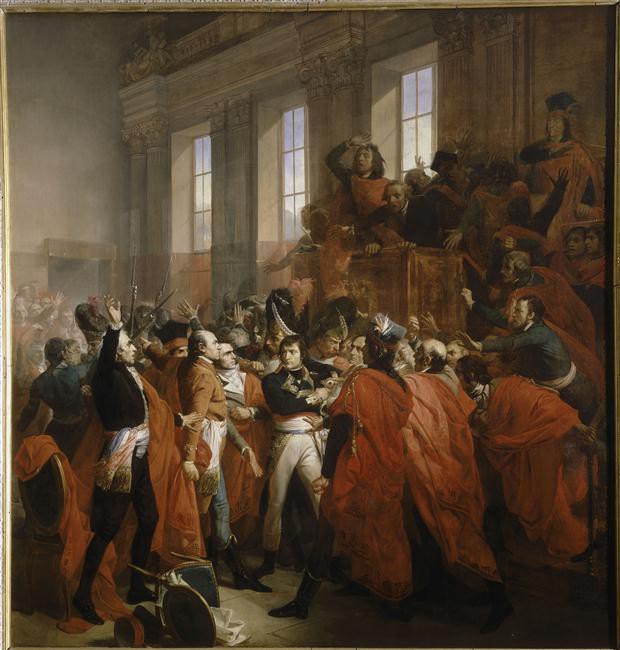
THE Insurrection D'ETAT OF xviii BRUMAIRE YEAR VIII
In 1799 the Directory was a authorities in decline, decadent and hated by the French. Some of the Directors solicited Bonaparte's return from Egypt, who agreed to assist them overthrow the authorities. On xviii Brumaire (9 Nov), the two legislative assemblies were moved to the Château de Saint Cloud under the pretext that they needed protection from a potential plot. Bonaparte was charged with the protection of the "deputes". He gave a confused speech in front of the assemblies; this caused trouble in the ranks, and Bonaparte was heckled past the men present. Lodge was restored thanks to the intervention of Full general Murat and his troops. The side by side morning, the constitution for a new, conditional government was passed. Revealing his political ambitions, Bonaparte imposed himself equally candidate for First Delegate. Under the new constitution of Yr 8 signed on 22 Frimaire Year Viii (thirteen December 1799), he could name non merely the members of the "Conseil d'État" who drafted the laws, but also ministers, ambassadors, ground forces officers and judges. The "Tribunat" and the "Corps législatif" were charged with the voting of the laws and the "Sénat" was the 'guardian' of the constitution.
The Consulate (1799-1804) oversaw the modernisation of France: the Banque de French republic was created and the currency stabilised, French republic underwent an administrative organisation (the cosmos of "départments" and "préfets"), the "Lawmaking Civil" was written, the "Légion d'honneur" was instituted, and canals, roads and tunnels were built throughout French territory. These new institutions created during the Consulate that survive to this twenty-four hour period were known as the "Masses de granite". Notice out more.
Did y'all know? Bonaparte's installation every bit First Delegate gave ascension to both Republican and monarchist opposition and that a number of plots would threaten the stability of the government. On 24 December 1800, while on his manner to the Paris Opera, Napoleon survived a bomb attack on rue Saint-Nicaise. Illustration: Bouchot, "Le Dix Huit Brumaire, 10 Nov 1799. Bonaparte in the conseil des Cinq-Cents at Saint-Cloud", Château de Versailles © RMN-Grand Palais (Château de Versailles)
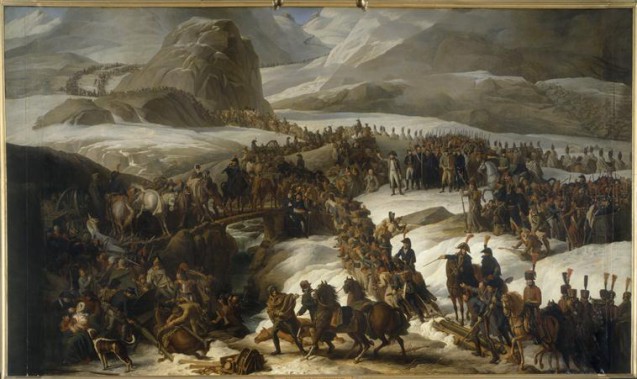
1800 – ITALY PART TWO: PEACE IN EUROPE
Austria and England were not prepared to accept the emergence in European politics of a Republican France under an ambitious First Consul Bonaparte. Full general Moreau was sent to fight Austrian presence in Germany, while Bonaparte looked to repeat his previous exploits of the outset Italian campaign. On 14 June 1800, he narrowly defeated the Austrians at Marengo, a victory that led to the signature of the Peace of Lunéville in February 1801. Subsequently numerous diplomatic exchanges, England signed the peace treaty of Amiens in 1802. Europe entered a period of relative peace…
Did you know? In order to grab the enemy unawares, Napoleon and his entire army, including canons, munitions and horses, crossed the Alps. During May there was heavy snow and the Austrians, who could not believe it, were taken completely by surprise.
Illustration: Thévenin, "The crossing of the Great St Bernard Pass, twenty May 1800. Château du Versailles © RMN-Grand Palais (Château de Versailles) / Gérard Absorb
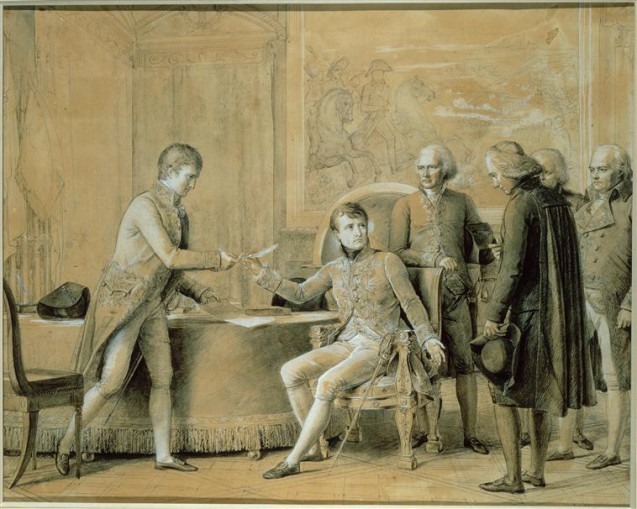
1801 – THE CONCORDAT, THE RELIGIOUS PEACE
Looking to wipe the slate make clean on an unequal, monarchist and catholic society, the French Revolution had suppressed Catholicism and abolished the clergy. The creation of a secular cult, unpopular and poorly supported past the population, had severely disrupted French lodge and succeeded only in setting French citizens against each other. Concerned for civic peace, Bonaparte entered into discussion with the Holy Meet (the central government of the Catholic Church), resulting in the signature of the Concordat on 15 July 1801. Catholicism was recognised as the "religion of the French bulk" and places of worship were reopened. Nevertheless, Bonaparte reinforced his control over the church by obtaining the power to name bishops, and the introduction of an adjuration of loyalty to the government that the clergy had to take.
Did you know? "Les Articles organiques" were appended to the Concordat after ratification by the Catholic Church. These "Articles", which were never approved by the Pope, immune Bonaparte to reinforce his political say-so over the spiritual authorization held past the church since the Centre Ages.
Illustration: Baron Gérard, "The signing of the Concordat between France and the holy see, fifteen July 1801", Musée National du Château de Versailles © RMN-K Palais (Château de Versailles) / Gérard Blot
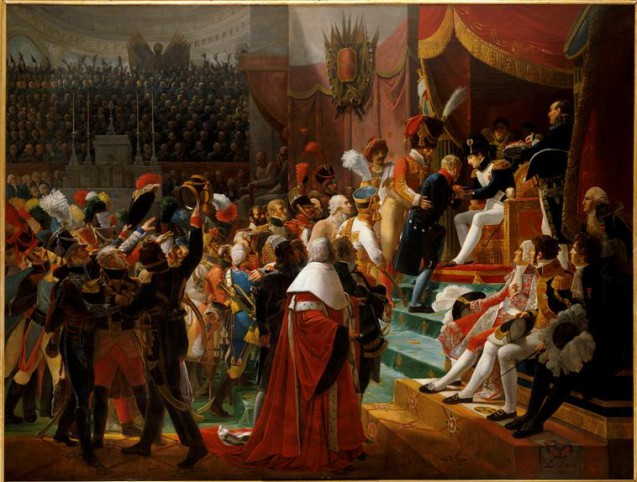
1802 – THE ORDER OF THE LÉGION D'HONNEUR
A few days later having been voted "Consul for life" by the Sénat on 12 May 1802, Napoleon founded the order of the "Légion d'honneur" ("Legion of honour") on 19 May 1802. After the disruption of the Revolution, this ornament intended to bring together French citizens based on values and talents such as courage, civic ingenuity, and art. It was not a war machine honor; civilians, industrialists, scientists and artists, and men and women alike, could all receive the award. Besides the medal and a title ("Grand Officier", "Commandants", "Officier", "Légionnaire"), the recipient as well received a regular allowance for life. The legionary had to pledge loyalty to the Republic and its government (and afterwards on to the Empire and the Emperor).
Assistance could also be accorded to needy members and, concerned about the education of immature girls, Bonaparte introduced educational centres for the daughters and granddaughters of titulars. The Légion d'honneur was accorded for the first time on 15 July 1802 at a grand and impressive ceremony held in the church of Saint-Louis des Invalides.
Did you know? The Légion d'honneur is part of the 'masses de granit', the proper name given by Napoleon to what he considered to be his near of import laws that reorganised French republic during the Consulat.
Illustration: Debret, "First distribution of the Croix de la Légion d'Honneur in the Church of Les Invalides", Château de Versailles © RMN-Grand Palais (Château de Versailles)
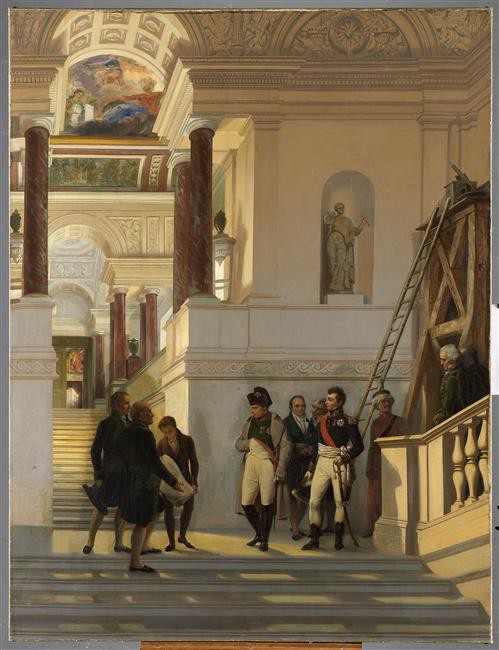
1803 – THE MUSÉE NAPOLÉON
In 1792, the Muséum Primal des Arts was created, situated in the Palais du Louvre. The aim was to join the works of the greatest painters and sculptors, assuasive the general public to admire them and artists to be inspired by them. In 1802, Napoleon named as head of the museum Vivant Denon, a man of prodigious creative talents who had also accompanied Napoleon on his Egyptian expedition. Denon was in charge of acquisitions and official commissions for not only for the Musée Napoléon (equally it was renamed in 1803) but also for the fifteen new provincial museums, created in Lyons, Bordeaux and Marseilles and other towns. Through the wealth of its collections, the museum was to reflect the power of the French state. Throughout his reign, Napoleon continued to re-organise the Palais du Louvre; he also commissioned contemporary artists to paint his portrait celebrating his political power, as well equally works depicting (in the best light, of course) the events and the great successes of his reign, including coronations, Regal marriages, treaty signatures and armed forces victories. Every two years, the "Salon" for living artists would put on a public display of its works; some of these would stop up hanging in royal palaces or becoming diplomatic gifts.
Did y'all know? During the Revolutionary and Napoleonic Wars, the French government enriched its collections by taking many works of arts from the museums of its defeated enemies? After the fall of the Empire, a large number of these works were returned to their original homes.
Analogy: Couder, "Napoleon I visiting the staircase of the Louvre guided by the architects Percier and Fontaine", Musée du Louvre © RMN-M Palais (Musée du Louvre) / Thierry Ollivier
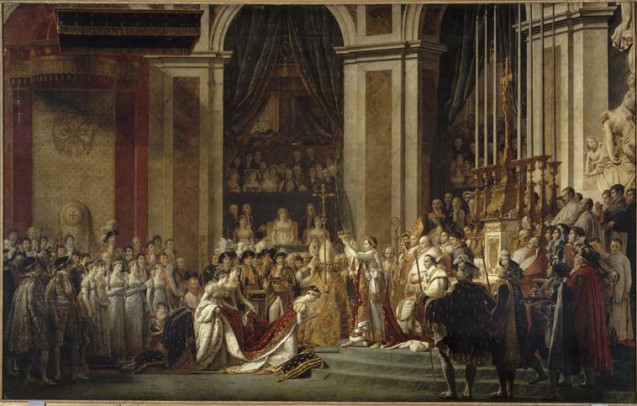
1804 – A Yr OF CONTRASTS
After the foiling of a royalist plot in March 1804, Napoleon suspected that the duke was the instigator. After multiple attempts on his life, Napoleon wanted to put an end to these assassination plots too as protect himself confronting any possible return of the Bourbon monarchy. The duke was arrested and, afterwards a quick trial, executed on 21 March. His expiry gave rise to cries of protest in every purple court in Europe.
Almost a calendar month later, a new constitution was created: the First Empire was proclaimed by the senatus-consulte (vote of the Senate by constabulary) of 28 Floreal, Year XII (xviii May 1804). This senatus-consulte was approved on 6 November later the same year.
On 2 December 1804, Napoleon was crowned Emperor of the French. Over 12,000 people were present at the ceremony which lasted for more than than 4 hours in the freezing Cathedral of Notre-Dame. The Pope as well made a special trip from Rome for the ceremony. However, in placing the crown upon his head himself and crowning his own wife Josephine, Napoleon succeeded in reducing the Pope to a simple approval of the ceremony, thus reaffirming his power in face of the Catholic Church. Napoleon planned every detail of the anniversary which was intended to put him on an equal footing with other European monarchs. However, just a few months earlier, the godson of Louis XVI, the Duc d'Enghien, had been executed on Napoleon's orders.
Analogy: David, "The coronation of Emperor Napoleon I and the Empress Josephine at Notre Matriarch de Paris, 2 Dec 1804", Musée National du Château de Versailles © RMN-Grand Palais (musée du Louvre) / Hervé Lewandowski
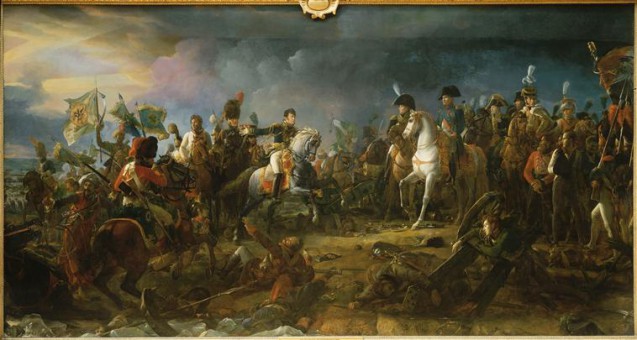
1805 – VICTORY AT AUSTERLITZ
In 1805, England organised a new coalition against France, which included Austria, Prussia and Russian federation. The Grande Armée (the French Purple army) won a series of victories, including Ney's victory at Elchingen on 14 Oct and Napoleon'south victory at Ulm on 20 October. French troops entered Vienna on fourteen Nov, and on 2 December, a year after his coronation in Paris, Napoleon crushed the Russian and Austrian troops at the Boxing of Austerlitz. The Austrians signed the peace treaty at Presbourg on 26 Dec. The war lasted for two years: the French double-victory at Jena and Auerstadt on xiv October 1806 against the Prussians followed by victory over Russia at Friedland on fourteen June 1807 confirmed Napoleon's dominance in Europe. On eight July 1807, Russian federation and Prussia were forced to sign the peace treaty at Tilsit, and Napoleon created the Duchy of Warsaw from Polish territory taken from Prussia.
Illustration: Gérard, "Battle of Austerlitz, ii December 1805", Musée National du Château de Versailles © RMN-Yard Palais (Château de Versailles)
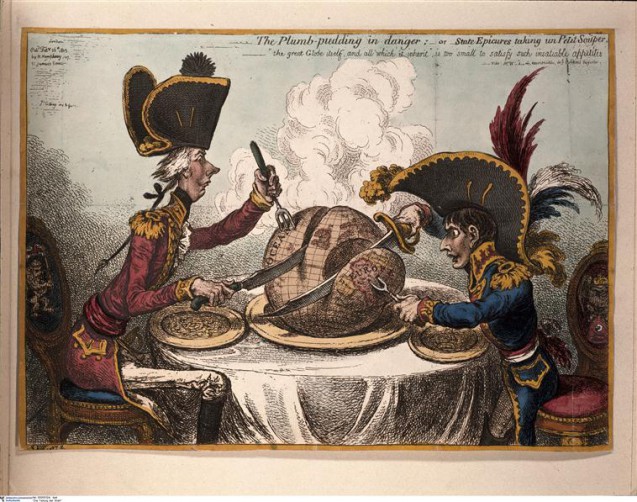
1806 – TOWARDS THE One thousand EMPIRE
In 1806, Napoleon appeared invincible. Emperor of the French since 1804, he as well became Male monarch of Italy in 1805, Protector of the German Confederation in 1806 and had been Mediator of the Helvetian Confederation since 1803. Little by little he installed family members on the European thrones: his stepson Eugene de Beauharnais was made Viceroy of Italia in 1805, his brothers Louis and Joseph became Kings in Holland and Naples respectively in 1806, and after on, in 1807, Jerome was named to Westphalia. In 1808, his brother-in-constabulary Murat was also installed as King of Naples.
However, the master enemy was still England, who controlled the seas and globe trade. The evolution of English language industries, notably textiles, rested on the exportation of the raw materials from the colonies in Bharat and the Caribbean. Realising that he could non launch a direct assault on the English navy (the French suffered a bitter defeat at Trafalgar in 1805), Napoleon decided to weaken England'due south economic system by imposing a continental occludent in 1806. A prescript obliged all French and allied ports (including Holland and Spain) to refuse entry to British ships. All the same, some of the allies were reluctant to apply the blockade with whatever real conviction for fear that their own trade would endure, and smuggling increased. On top of this, Napoleon was forced to mobilise a lot of men to oversee the blockade, many of whom were taken from regular army contingents.
Illustration: James Gillray,Dividing up the world © RMN. Extravaganza showing Napoleon (right) and the British Prime-minister William Pitt (left) in 1805 greedily serving themselves large portions of the globe.
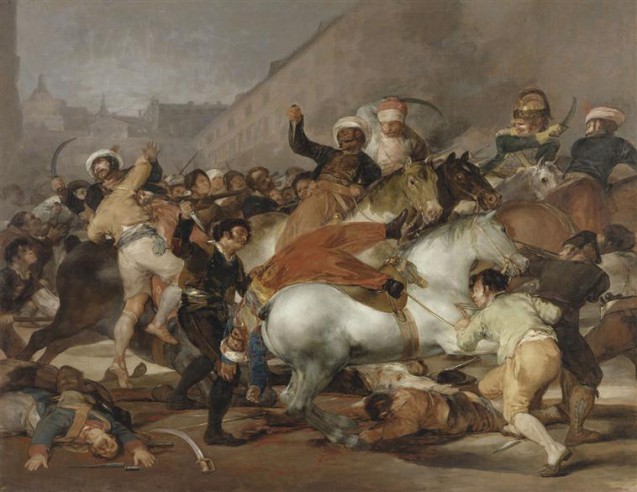
1808 – THE Castilian Entrada
Traditionally, Spain had been an ally of France, playing an important function in the continental blockade of England trade. However, in April 1808, Napoleon's concern over dynastic conflicts between the king of Spain Charles IV and his son Ferdinand led him to install his ain blood brother Joseph Bonaparte on the Spanish throne. The new rex was poorly received past the people in Madrid and at that place was an uprising on two May. French republic's repressive response on 3 May fuelled opposition in the land, which was supported by a heavyweight ally, England. Napoleon was victorious at Somosierra on 30 November and Madrid capitulated on 4 December, but he was soon obliged to return to Paris due to the Austrian threat. The disharmonize, a real war of independence for the Spanish, also contributed to the weakening of the Napoleonic army and served to demonstrate to the whole of Europe that it was no longer invincible. Despite several victories, the French troops, exhausted by obstinate guerrilla fighting, were defeated at Vitoria on 21 June 1813 and soon afterward Joseph was forced to yield the throne to Male monarch Ferdinand VII.
Illustration: Goya, Dos de Mayo 1808, Madrid (the 2nd May) © Museo Nacional del Prado, Dist. RMN-GP
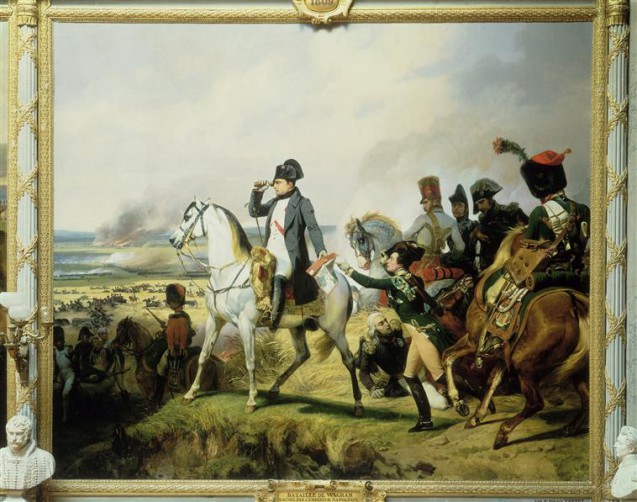
1809 – A Difficult AUSTRIAN CAMPAIGN
In April 1809, Austria was looking for revenge. Thus began the hardest-won campaign of Napoleon's career, a entrada notable for its victories (Eckmühl on 22 April, Ratisbonne on 23 April and Wagram on 6 July) merely also for its defeats (the battle of Essling on 20-21 May for example). The victory at Wagram on6 July imposed peace on the Austrians, which was signed in Vienna on 14 October. Likewise every bit losing Galicia to the Duchy of Warsaw, Austria was forced to yield to French republic all of its Adriatic territories. On 12 October Napoleon, who was in Vienna for the signature of the peace treaty, survived another bump-off try. Whilst observing a military parade at Schönbrunn Palace, Napoleon was approached by a swain who put his hand to his coat, ready to brandish a dagger. An officeholder stopped him in time, and Napoleon was not even aware of what had happened. The son of a German pastor, Frédéric Staps had decided to eliminate the "tyrant" Napoleon. The Austrian defeat put an stop to any promise of liberation from French dominance that the German language states had. Staps was initially sentenced to expiry, but to avoid any patriotic popular uprising, Napoleon had him alleged insane – he was all the same later executed.
Illustration: Vernet, "Napoleon I at the Boxing of Wagram, 6 July 1809, Musée National du Château de Versailles © RMN-Grand Palais (Château de Versailles)
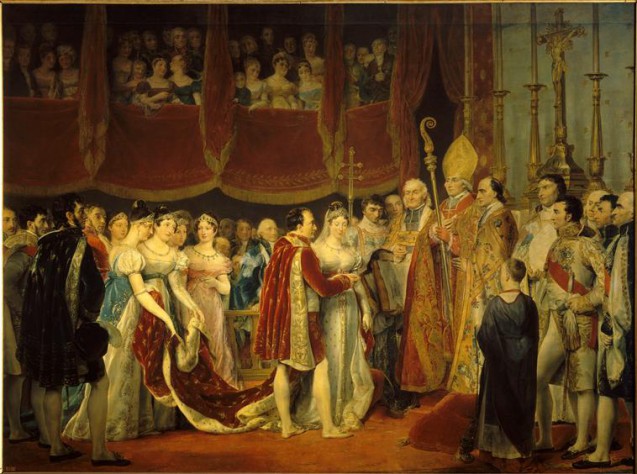
1810 – A NEW Hope
In December 1809, Napoleon I divorced Empress Josephine who, despite producing two children from her outset spousal relationship (Eugene and Hortense de Beauharnais), had failed to requite him a son that would consolidate the Royal government and perpetuate the new reigning dynasty, the Bonapartes. In 1810, Napoleon engaged Tsar Alexander I on the possibility of marrying one of the Russian monarch's sisters. When Alexander refused, Napoleon turned to his forced 'ally', Austria. On 1 April, he married the young Archduchess Marie-Louise Habsburg, daughter of the Emperor Francis I. A yr later on, on 20 March 1811, the new Empress gave birth to a son named Napoleon afterward his father and given the title "Roi de Rome" (Male monarch of Rome). More most the Roi de Rome.
Did you know? Marie-Louise was the grandniece of Queen Marie-Antoinette (1755-1793). Ironically, this made Napoleon the corking nephew, by union, of Louis XVI.
Illustration: Georges Rouget, The Religious spousal relationship of Napoleon and Marie-Louise, 2 April 1810 in the Salon Carré at the Louvre, © RMN-Grand Palais (Château de Versailles)
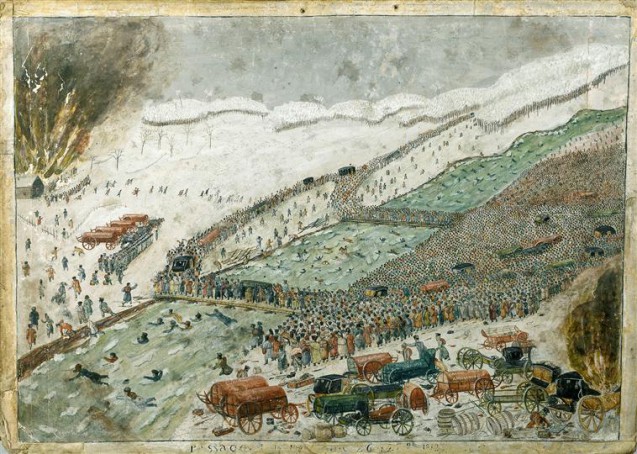
1812 – THE RUSSIAN DISASTER
The peace at Tilsit in 1807 did not preclude Franco-Russian antagonism for long. Alexander I could not have the cosmos of the Duchy of Warsaw and was becoming impatient regarding war with the Ottoman Empire and its division. Taking the French looting of the German language Duchy of Oldenburg as a pretext, he declared state of war on viii April 1812. In June, Napoleon invaded Russian federation with a force of 480,000, keeping in reserve another 120,000 soldiers. The Russian tactics centred on refusing battle, disrupting the French forces and forcing them to spread out and become dispersed.
The French easily took Vilnius and then Smolensk but on 7 September, neither Napoleon nor Koutousov emerged victorious from the battle of Borodino, at the gates of Moscow. A week later, the French entered a city soon to be consumed in flames; the Russians had sacrificed it in order to destroy any supplies or ammunition from which the French could have profited.
Napoleon thus began his retreat on 18 October. The army experienced bully difficulty in crossing the swollen Berezina (a river in Belarus) 28-29 November, and Napoleon, warned of a possible coup d'état in Paris, was forced to push on ahead. He left Ney and Murat in charge of the remaining troops, merely the horrendous atmospheric condition conditions meant that merely 20,000 soldiers returned to France alive.
Illustration : François Fournier-Sarlovèze, The French army crossing the Bérésina, 28 November 1812 © Paris – Musée de l'Armée, Dist. RMN-One thousand Palais Pascal Segrette
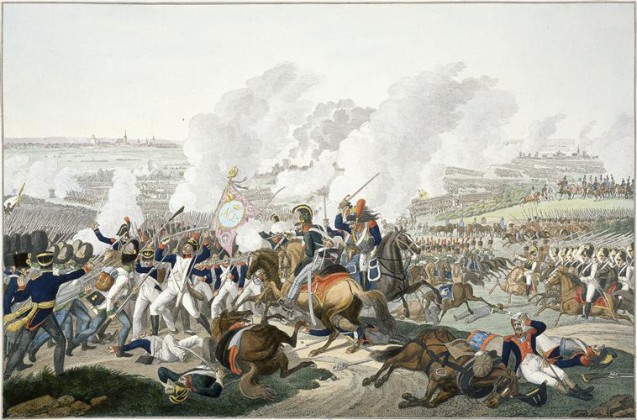
1813 – THE BATTLE OF LEIPZIG
In 1813, as the exhausted Grande Armée returned to France from Russia, a Russo-Prussian coalition was formed. Despite ii victories at Lützen on ii May and at Bautzen on xx May, Napoleon was defeated on xvi and 19 October at the Battle of Leipzig (known as the "Boxing of the Nations" because of the number of nationalities involved – French, allied with Poles, Neapolitans, Saxons (the Kingdom of Saxony changed sides) against the Russians, Austrians, Prussians and Swedes – equally well equally the number of soldiers nowadays – nearly 200,000 men on the French side, and more 300,000 on the coalition side). Upon hearing the news of this defeat, Belgium and The netherlands rebelled while Austria, with the back up of Murat, began re-establishing itself in Italia. And with Spain lost, France was all that remained for Napoleon.
Illustration: later on Johann Adam Klein,Boxing of Leipzig, 16, xviii et xix October 1813 © Paris – Musée de l'Armée, Dist. RMN-M Palais
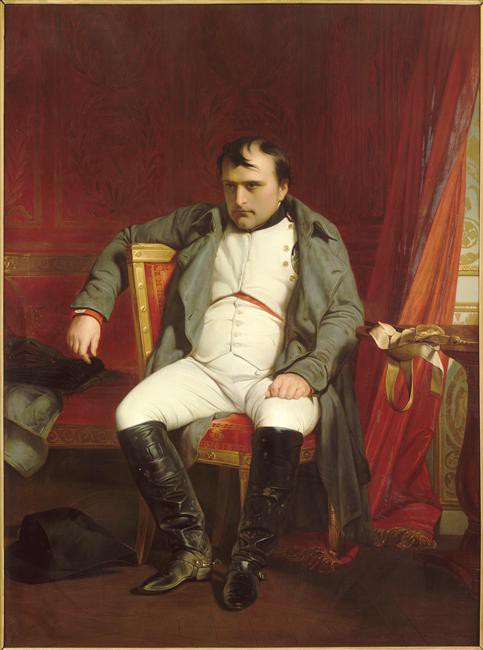
1814 – THE FRENCH CAMPAIGN
Later on the defeat at Leipzig, English language forces invaded southern France while the Prussians, Austrians and Russians threatened Paris. On 24 January 1814, Napoleon entrusted the regency to the Empress Marie-Louise and took accuse of an army of 60,000 young soldiers. Despite French victories at Brienne (29 January), Champaubert (10 Feb) and Montmirail (11 February) in the face of much larger enemy forces, Napoleon could not preclude the invading coalition from entering Paris on 31 March 1814. When he learned of the capitulation of the uppercase, he made a U-turn and headed for the Chateau de Fontainebleau, the nearest Imperial residence.
On 2 April, the Senate voted in favour of deposing the Emperor, and at Fontainebleau Napoleon abdicated, in favour of his son, Napoleon Ii. Just by 6 April, the abdication was unconditional. He was exiled to the island of Elba and Louis XVIII was restored to the Bourbon throne.
More about the French Campaign
Illustration: Delaroche, Napoleon I at Fontainebleau, 31 March 1814 © Paris – Musée de l'Armée, Dist. RMN-Grand Palais
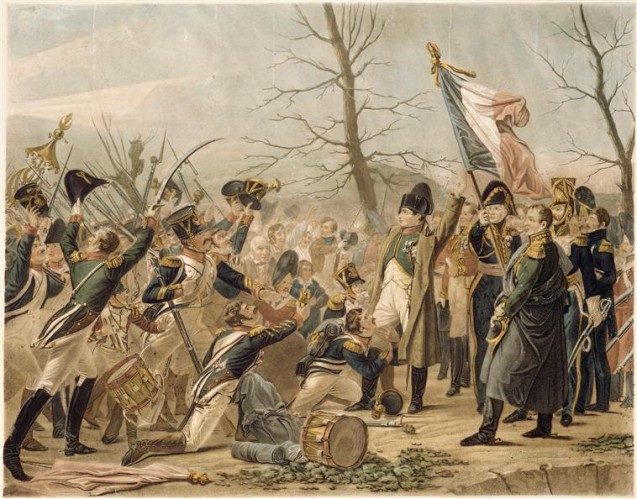
1815 – A Yr LIKE NO OTHER
On 1 March 1815, Napoleon landed at Golfe Juan, crossed the Alps and arrived in Grenoble where an ground forces commanded by Ney awaited him. On 20 March, Napoleon took dorsum possession of the Palais des Tuileries, abased the previous day by Louis 18, who had fled to Belgium. Napoleon decided to pre-empt the allied forces and invaded Kingdom of belgium with a force of 130,000 soldiers.
After defeating Blücher'south Prussian troops at Ligny on 16 June, he prepared for the decisive battle at Waterloo, south of Brussels. Withal, a combination of Ney and de Soult'due south blunders, Grouchy'south failure to comprise Blücher and prevent him from rejoining Wellington, and staunch English and Prussian resistance resulted in Napoleon's defeat on 18 June. Refusing to prolong a resistance entrada, as he was brash by a number of his close associates, Napoleon capitulated on 22 June.
Did y'all know? During the beginning few months of Louis Eighteen'south reign, the violet became the rallying keepsake for Bonapartists. This discreet spring flower was seen as a symbol of loyalty to Napoleon and indicated a hope that a Bonaparte would return to the throne.
Illustration : after Charles de Steuben, The return from Elba © RMN-Grand Palais (Musée des châteaux de Malmaison et de Bois-Préau) / Jean Schormans
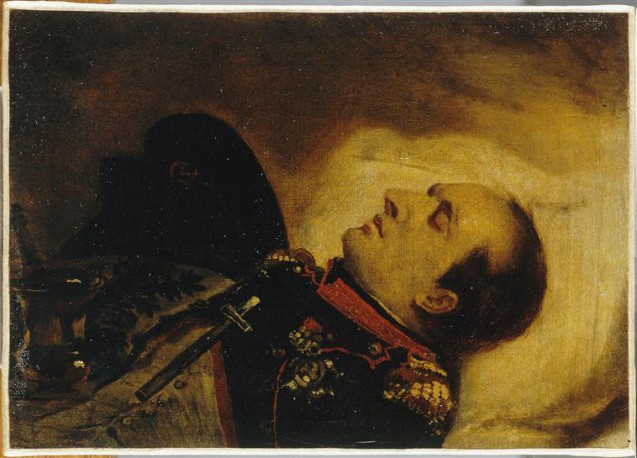
1821 – THE Death OF NAPOLEON AT ST HELENA
On 22 June 1815, iv days later on the defeat at Waterloo, Napoleon abdicated for the second time in his reign. He initially fabricated for the island of Aix, from where he hoped to set sail for (possibly) the United States. At the same time, the English and French were working to forestall his escape. He eventually surrendered to British forces on 14 July; he soon learned that his captors had decided to exile him to the island of St Helena, a small isolated island in the middle of the South Atlantic Bounding main. He was joined in exile by some of his loyal supporters: Marshal Bertrand, Count Montholon and their wives; Count de Las Cases and his immature son; General Gourgaud and ten servants, including Marchand and Saint-Denis. On 17 October 1815, after a voyage of more than than two months, Napoleon landed at St Helena: accessible but via a small port surrounded past tall cliffs, information technology was the perfect natural prison. At his residence at Longwood, originally a barn, with damp and dark rooms, Napoleon dedicated himself to dictating his memoirs. Many hours were spent, not but reliving his greatest moments, but too explaining the errors of his reign. Each day Napoleon's health worsened due to the poor climate, a lack of privacy and the general tedium of an existence marooned on an isolated island over 2000 km from any landmass. Napoleon's moods swung between bouts of low, during which time he would pass up to leave Longwood, and periods of intense activity, including the conception of a new garden. His concluding words before his death on 5 May 1821 were of Josephine and the army.
More near Napoleon's life in exile
Illustration : Jean-Baptiste Mauzaisse, Napoleon I on his deathbed 5 May 1821 © RMN-G Palais (Musée des châteaux de Malmaison et de Bois-Préau) / Michèle Bellot
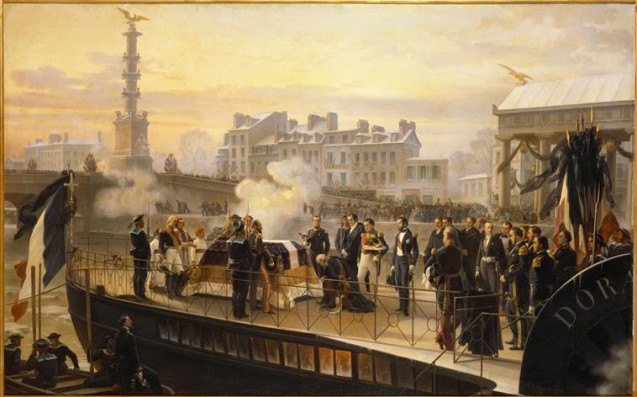
1840 – LE RETOUR DES CENDRES
Eighteen years after the decease of Napoleon in exile on the island of St Helena, with the legend of Napoleon at its apogee, King Louis-Philippe organised the return of Napoleon'due south mortal remains.
On 15 December 1840, a big crowd gathered along the route of the procession. Many had non experienced life under the Empire simply their imaginations had been captivated by the tales of their elders.
The funeral coach was 11 metres tall, drawn by sixteen horses, and adorned with golden caryatids supporting a display bury. Napoleon's actual bury was hidden in the base of operations of the carriage. No members of the Purple family were able to attend the ceremony as they were all the same banished. The trunk of Napoleon at present rests in the crypt of the Dome Church building at Les Invalides. 100 years after, the torso of his son, who died in 1832 at Schönbrunn, was interred side by side to Napoleon.
Did y'all know? In France during the 19th century, the word "cendres" ("ashes") was systematically used to refer to a person'south mortal remains even if they had non been cremated.
Illustration : Henri-Félix-Emmanuel Philippoteaux,The render of the mortal remains of Napoleon I, Dorade arrives in Courbevoie, 14 December 1840 © RMN-Thou Palais (Musée des châteaux de Malmaison et de Bois-Préau) / Daniel Arnaudet
How did Napoleon spend his time?
Find out in our Napo Factfile: A Day in the Life of Napoleon I.
sherlockfainterep.blogspot.com
Source: https://www.napoleon.org/en/young-historians/napodoc/timeline-consulate1st-french-empire/
0 Response to "1700s Napoleon Bonaparte Review of the Troops Print"
Post a Comment